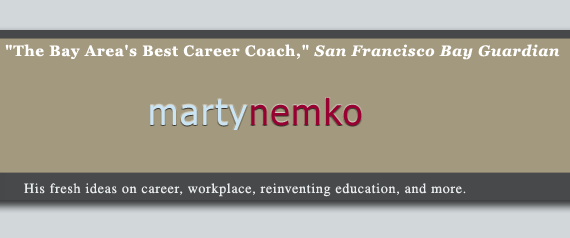Education Reinvented
By Marty Nemko
We’re all taught to think outside the box. I’m hoping that the idea presented in this column will help trigger your out-of-the-box thinking related to your worklife. And if you’re in the field of education, one of the Bay Area’s largest employment fields, it may be additionally relevant to you.
We give high school diplomas to people with frighteningly poor ability to read, write, use computers, and most important, reason. Not only is the result of education bad, so is the process. Most students dislike school, at least the academic part. Teachers don’t like it either. 46 percent of high school teachers leave within five years.
So-called school reform has gone on for decades, but it’s mainly a pendulum that swings from Method A to Method B and back--for example, ability-grouped to mixed-ability classes and back, back-to-basics to holistic education and back. But education’s core structure—a teacher with a class of 30 students in a school—remains essentially as it was centuries ago.
It’s time for education to be not reformed, but reinvented. Of course, students need academics, extracurriculars, socialization, and more, but using the school building as the primary vehicle seems, to me, obsolete.
Here is what I believe is a smarter approach to both high school and college education. It also is relevant to corporate training. I call it Ed2.
The Ed2 “school” day would be divided into three parts: online, mentorship/fieldwork, and extracurricular.
8 AM – 12 Noon The student, at home, would go to a website, his or her online school and sign in with a fingerprint ID. At random intervals, the student would re-sign-in to ensure the student was doing his own work.
Each morning, the studentwould participate in five individually-paced courses, some semester-long, some shorter. Because the courses would be delivered online, each one could be taught by a world-class instructor. Thus, if Ed2 were replicated nationally, every student, rich or poor, in the US (and beyond?) would receive a superb teacher instead of a random one. And instead of we, the taxpayers, paying for 30,000 teachers and 30,000 classrooms, we would be paying for one.
Most class sessions wouldinclude mini-lectures, demonstrations, and importantly, simulations—opportunities for students to try thingsinfeasible in the real world—for example, trying to restore an ecosystem or solve the Palestinian/Israeli crisis.
Content that’s irrelevant to most students’ lives such as quadratic equations, the Peloponnesian Wars, and the halide series of chemical elements would be replaced by crucial learning usually omitted from the curriculum, for example, conflict resolution, entrepreneurship, ethical citizenship, financial literacy, and advanced Internet searching.
Students needing assistance could email or phone the live instructors available for that purpose.
For each course, each student would choose to participate in one of three types of discussion groups:
--real time online, for think-on-their feet students,
-- asynchronous online, often preferred byreflective students, or
-- in-person at school, for students whovalue face-to-face contact more than the convenience of online discussions.
Tests would be graded instantly by computer, with open-ended questions graded by live teachers. Those live teachers would also provide low- and high-scores with extra help or revised curriculum.
A student could test out of any course—we want to credit accomplishment, not seat time.
1 PM to 3 PM Students would report(in person, by phone, or online depending on the situation) to their mentor—a seven-week-long renewable pairing with an adult.
The pairing would be based on questionnaires completed both by mentor and student, akin to match.com. For example, a student who aspires to be a physician might be mentored by a coroner and get to observe and participate in autopsies. An aspiring businessperson might be mentored by a retired executive and together, create and perhaps even implement a business plan.
Each student would spend at least one semester in a service learning setting, for example, Habitat for Humanity or in a city council member’s office.
Mentors and students would receive training on how to make the most of the mentoring relationship.
3 PM to 5 PM Students would meet in a school for sports, art, theater activities, and other non-academic and socialization activities.
No new schools will be built. Any need for additional space would be filled by leasing space from churches and at-work people’s living rooms or family rooms that sit empty all day. So many group activities—from rehearsing scenes from a play to club meetings-- could be conducted in homes. The cost of leasing and insurance is tiny compared to that of constructing and maintaining new buildings.
How could such a radical change be implemented when even modest school reform proceeds at glacial speed? The schools are too beholding to the status quo’s beneficiaries to support this idea. A foundation should fund a rigorous pilot test of the program. If successful, it should be promoted to the general public via the media.
Now, I turn to you, my reader. In your work, if you tossed aside all elements of the status quo and tried to build a better mousetrap from ground zero, what would you do?
Dr. Nemko welcomes feedback on this proposal. Send it to mnemko@earthlink.net.© Marty Nemko 2004-2024. Usage Rights

